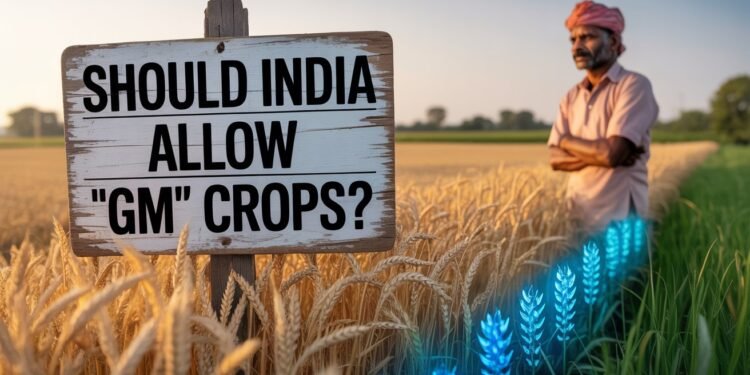Author: Vijeta Raj, Final-year B.Sc. (Hons.) Agriculture Student, Rani Lakshmi Bai Central Agricultural University, Jhansi
Introduction:
India stands at a crossroads: it has two decades of experience with Bt cotton, recent regulatory moves on gene-edited plants, and heated public debate (notably over GM mustard). This article explains what genetic modification and CRISPR/gene-editing are, recounts India’s regulatory and historical path, weighs legal, social, health, environmental and agricultural implications, and concludes with pragmatic policy recommendations and a global perspective.
- Quick primer: what is genetic modification and what is CRISPR?
Genetic modification (GM / transgenic crops) means deliberately changing an organism’s DNA to add, remove, or alter genes. Traditional GM crops (the first generation) were usually produced by inserting genes from another species (transgenes) to confer traits such as insect resistance (e.g., Bt) or herbicide tolerance. Evaluation of these crops focuses on direct toxic/allergenic risks, nutritional changes, gene stability and unintended effects. International organizations (WHO, FAO, Codex) provide frameworks for safety assessment
CRISPR and modern gene-editing. CRISPR–Cas9 and related systems are genome-editing tools that let scientists make very precise changes at chosen DNA locations: knock out a gene, tweak its expression, or (less commonly in plants) insert sequences. Unlike classic transgenic approaches, some gene-editing outcomes (often called SDN-1/SDN-2) do not introduce foreign DNA and instead create small edits indistinguishable from natural mutations or conventional breeding outcomes. CRISPR is faster, cheaper and more flexible than older methods, but brings its own safety questions (off-target edits, unintended effects) that must be assessed.
- Short history of GM crops in India (high-level timeline & milestones)
- 2002 — Bt cotton commercialised. India approved Bt cotton (Bollgard/Mahyco-Monsanto) and it rapidly became the dominant cotton variety; studies show large adoption and major agronomic/economic effects (reduced some pesticide use; contested impacts on yields and farmer incomes).
- Subsequent moratoria & debate. Edible GM food crops remained politically sensitive. Field trials and commercial release of food crops faced heavy opposition and regulatory caution (e.g., brinjal/Bt eggplant approval was stalled in 2010 following public controversy).
- 2022–2023 — gene-editing and GM mustard controversy. In March 2022 India revised rules to allow some gene-edited crops (those without exogenous DNA; SDN-1/SDN-2) more flexibility for field trials. In October 2022 GEAC granted environmental release for a transgenic mustard hybrid (DMH-11 / “GM mustard”), a first for an edible transgenic food crop; that approval was later stayed/subject to legal challenge and a split Supreme Court verdict in 2024 highlighted continuing judicial and public scrutiny
- India’s regulatory framework — who decides what?
India’s GMO regulation sits mainly under the Environment (Protection) Act, Rules 1989, and the Genetic Engineering Appraisal Committee (GEAC) is the apex body for environmental release approvals. The Department of Biotechnology (DBT) and other bodies (Review Committee on Genetic Manipulation RCGM; Institutional Biosafety Committees IBSCs) produce technical guidance. In 2022 DBT issued genome-editing guidelines clarifying how SDN-1/SDN-2 edits are to be handled, creating a two-track regulatory reality: classical transgenic crops remain stringently regulated, while certain gene-edited plants face lighter oversight if they contain no foreign DNA. The regulatory architecture is robust on paper but criticized for opacity, inconsistent risk-communication, and slow, politicised decision processes.
- Health and safety prospects
Scientific consensus (global) on currently commercialized GM foods: Major bodies (WHO, FAO, Codex, OECD) state that foods derived from modern biotechnology that have passed required safety assessments are not inherently more risky than conventional foods; risk assessment should be case-by-case. However, long-term and ecological consequences are harder to generalize and depend on the trait and context.
India-specific evidence: Bt cotton studies indicate reduced insecticide use in many regions, but debate persists about long-term socio-ecological impacts and localized farmer outcomes. For newly approved crops (e.g., GM mustard), Indian scientists and committees recommended targeted studies (effects on pollinators, gene flow, nutritional equivalence) as conditions for release showing regulators are aware of health and environmental questions but judicial/public scrutiny remains high.
Risks to manage: potential allergenicity or toxicity (trait-dependent), horizontal gene transfer (generally low concern for food safety), off-target edits in gene-edited plants (technical risk that requires sequencing and testing), ecological impacts (weediness, effects on non-target species, pollinators), and pesticide-related impacts in herbicide-tolerant stacks. Robust pre-market risk assessment, post-release monitoring and independent research can reduce these risks.
- Agricultural and socio-economic implications
Potential benefits
- Productivity & input reduction: Traits such as pest resistance (e.g., Bt cotton) have reduced some pesticide use and, where deployed well, boosted yields or lowered input costs. For India, crop traits tailored to local pests, drought tolerance, or improved oilseed yields (mustard) could improve food security and reduce imports in specific sectors.
- Climate resilience: Gene-editing can accelerate breeding for heat/drought tolerance or nutritional improvements (biofortification) faster than conventional breeding in some cases.
Concerns
- Seed sovereignty & concentration: Dependence on proprietary seed/traits can reduce farmer autonomy and increase costs (royalties, restrictions on seed saving), a major political issue in India. Bt cotton’s commercial rollout raised such questions about pricing, licensing and corporate-farmer relations.
- Uneven outcomes: Economic outcomes vary by region, crop, farm size and access to extension a crop that helps irrigated large farms may disadvantage smallholders unless policies target inclusivity.
- Biodiversity & interchange with organic/agroecological systems: Gene flow to wild relatives, loss of crop diversity, and conflicts with organic/GM-free supply chains are real management challenges.
- Legal, governance and societal dimensions
- Public trust & transparency. Indian experience shows that technical approvals without clear, accessible risk-communication fuel distrust. The GM mustard case and earlier controversies illustrate the need for transparent data sharing, independent peer review, and inclusive stakeholder consultation.
- Judicial involvement. Courts have been central in adjudicating biotech disputes in India (e.g., stays, petitions). Legal clarity and predictable processes help both innovators and critics
- Intellectual property & farmers’ rights. India must balance incentives for R&D (IP, private investment) with the Protection of Plant Varieties & Farmers’ Rights Act and smallholder protections. Policy instruments (compulsory licensing, price regulation, mandated technology-fee caps for public sector varieties) can mitigate risks.
- Global perspective — who grows GM crops and why it matters for India?
Major agricultural producers of GM crops include the United States, Brazil, Argentina, Canada and others adoption is trait-driven (soybean, maize, cotton) and linked to farm systems, trade rules and domestic acceptance. Many countries follow Codex and FAO guidance for safety assessment; some (EU) are more precautionary and regulatory-heavy. India’s choices influence trade (exports/imports), access to technology, and domestic seed markets. Aligning Indian regulation with international standards—while preserving policy space for public interest will be critical.
- CRISPR/gene editing: special considerations (technical & policy)
- Regulatory nuance: Because certain gene-edited outcomes mimic natural mutations (no foreign DNA), some countries (and India’s 2022 guidance) treat them more leniently. This can speed innovation and reduce costs, but it also raises questions on traceability and labeling. India’s DBT guidelines carve out these categories but call for institutional oversight
- Technical safeguards: For CRISPR-derived crops regulators should require (a) whole-genome sequencing or targeted deep sequencing to detect off-targets, (b) compositional/nutritional equivalence studies, (c) ecological risk assessments (gene flow, non-target organisms), and (d) post-release monitoring and transparency of data and methods.
- Practical recommendations for India (policy-oriented, pragmatic)
- Case-by-case, trait-driven approvals. Continue treating each crop and trait individually: benefits and risks differ greatly between Bt cotton, herbicide tolerance, or nutrient enhancement. (Scientific consensus supports case-by-case assessment.)
- Transparent public data and independent reviews. Publish all safety/field trial data in accessible formats; mandate independent third-party assessments for environmental release decisions.
- Stronger post-release monitoring. Make monitoring plans mandatory, fund neutral institutions (ICAR/academic consortia) to run ecological/health surveillance.
- Protect smallholders & seed diversity. Enforce rules that allow farmer seed saving for public-sector varieties, cap technology fees where needed, and incentivize public-sector breeding of gene-edited varieties for public good (drought tolerance, nutrition).
- Clear labels & co-existence rules. Mandate traceability and coexistence protocols (buffer zones, stewardship) so organic and conventional supply chains can manage risk and choice.
- Public engagement & capacity building. Invest in science communication, involve farmer groups, civil society and independent scientists early in the process to build trust.
- Conclusion
There is no single yes/no answer. Evidence shows potential benefits (pest reduction, targeted yield/quality gains, climate resilience) if a rigorous, transparent, trait-by-trait regulatory process is followed, combined with policies that protect smallholders and biodiversity. India’s own experience with Bt cotton shows both gains and contested outcomes; the GM mustard episode demonstrates that public trust, data transparency and independent oversight will determine long-term acceptance. For CRISPR/gene editing, India’s calibrated approach (lighter rules for SDN-1/2) can accelerate beneficial innovation but must be paired with strict safety checks, traceability and equitable access. In short: permit with care not a blanket approval and design institutions so that safety, farmer welfare and democratic oversight are central.
References
- The World Health Organization — Food, genetically modified (Q&A / safety assessment). World Health Organization
- FAO / Codex Alimentarius — GM Foods Platform & guidelines on safety assessment of foods derived from recombinant-DNA plants. FAOHome+1
- Genetic Engineering Appraisal Committee (GEAC) — Regulatory Framework for GE plants in India (document). geacindia.gov.in
- Department of Biotechnology (DBT), India — Guidelines for Safety Assessment of Genome Edited Plants in India (2022). DBT India
- Press Information Bureau (PIB), Govt. of India — Approval for Genetically Modified Mustard (DMH-11 announcement & GEAC conditions). Press Information Bureau
- USDA / Global Agricultural Report — India Approves the Environmental Release of Genetically Engineered Mustard (GAIN report, Oct 2022). USDA Apps
- Research / reviews on Bt cotton in India and its impact (overview articles). Global Agriculture+1
- Genetic literacy / global gene editing regulation tracker (on India’s 2022 decision on gene-editing). Global Gene Editing Regulation Tracker
- Broad Institute — CRISPR research highlights & Q&A (what is CRISPR?). Broad Institute+1
- Nature & other peer-reviewed reviews on CRISPR/Cas9 and genome editing (technical aspects and applications). Nature+1
- WHO / FAO technical reports and Codex documents on safety assessment (background and international norms). World Health Organization+1
- Recent Indian news & analysis — Supreme Court split verdict on GM mustard approval (reporting on judicial developments & public debate). The New



